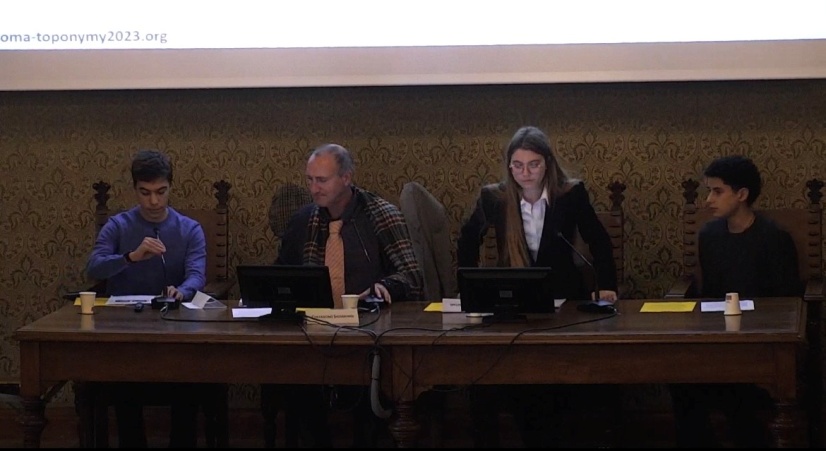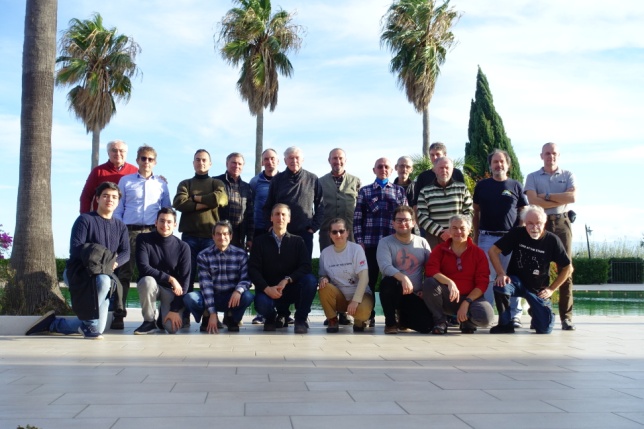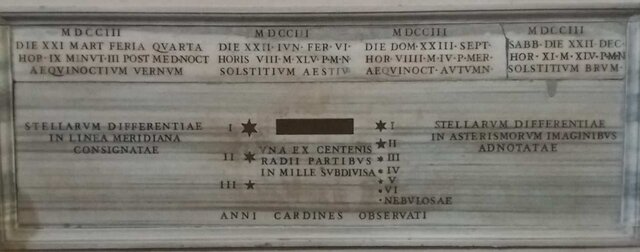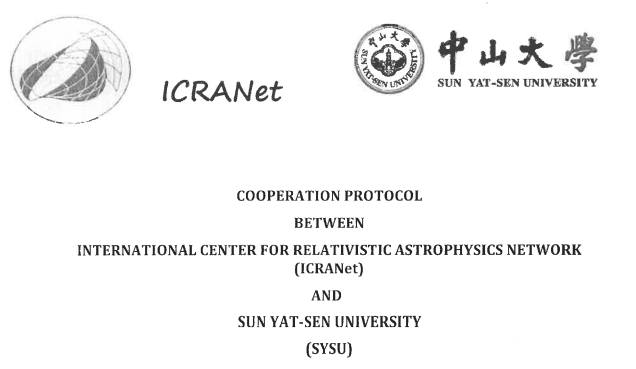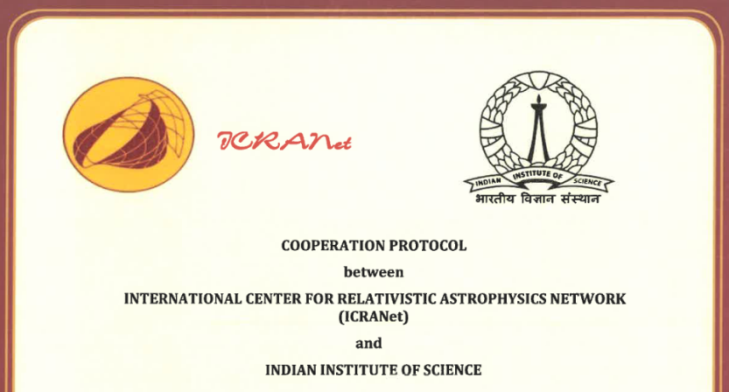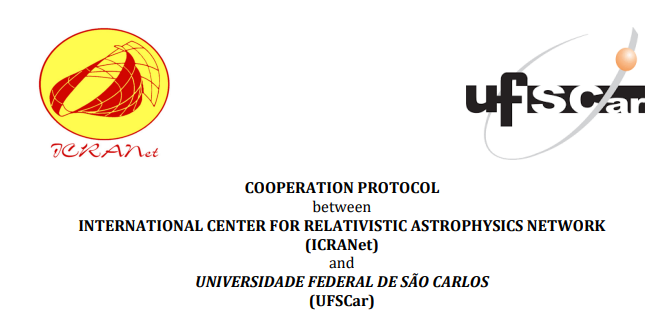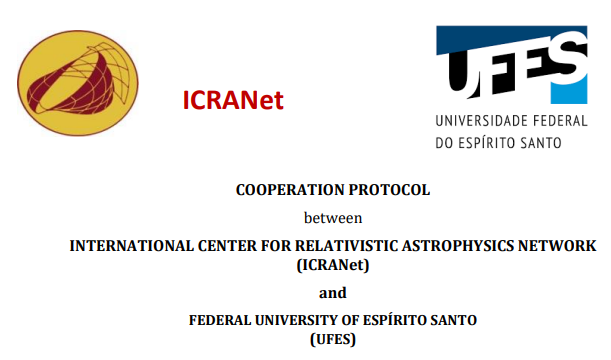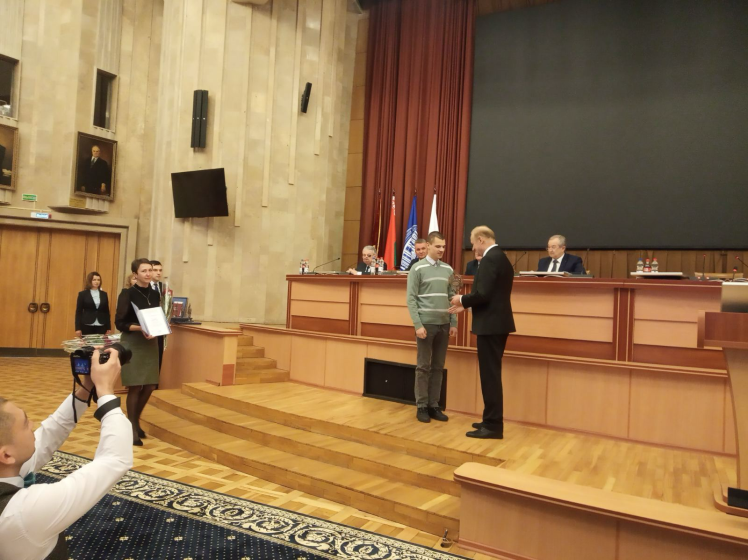

| November-December 2023 – January 2024 |

|

|
   ICRANet Newsletter
ICRANet Newsletter
November-December 2023 – January 2024
SUMMARY
1. ICRA – ICRANet – UNLP - INAF press release “Dark matter can solve the supermassive black-hole formation puzzle” 2. ICRANet participation at the International Symposium on Cosmology and Particle Astrophysics (CosPA 2023), November 10 – 13, 2023, Hong Kong and online 3. ICRANet participation at the inauguration of the academic year 2023/2024 at the University G. d’Annunzio of Chieti-Pescara, January 17, 2024 4. The Venus occultation by the Moonof November 9, 2023: observations and presentation at the Lincei Academy (Rome) 5. Observation of Betelgeuse occultation, December 12, 2023, Sibari (Calabria, Italy) 6. The scientific journal “BALMER” has been established at the Lincei Academy in Rome, November 24, 2023 7. IAU-NASE Workshop in memory of Prof. Jay M. Pasachoff, December 16, 2023 8. Two conferences of the winter's solstice astrometry at the Basilica of S. Maria degliAngeli in Rome, December 21 and 22, 2023 9. Renewal of the cooperation protocol between ICRANet and the Sun Yat-Sen University (SYSU), November 15, 2023 10. New cooperation protocol between ICRANet and Universidade Federal de São Carlos (UFSCar), December 1, 2023 11. New cooperation protocol between ICRANet and Indian Institute of Science (IIS), December 7, 2023 12.New cooperation protocol between ICRANet and Universidade Federal do Espírito Santo(UFES), January 10, 2024 13. The paper by Prakapenia and Vereshchagin is in the Top-10 list from the National Academy of Sciences of Belarus in 2023 14. Seminar of DrMeruertTakibayeva at ICRANet center in Pescara, November 15, 2023 15. Scientific visits to ICRANet 16. Recent publications
1.ICRA – ICRANet – UNLP - INAF
press release “Dark matter can solve the supermassive black-hole formation puzzle”
High-precision measurements of stellar
orbits in galaxies’ outskirts and central regions, together with theoretical progress combining particle
physics and general relativistic galaxy modeling carried out in the last decade at ICRANet, including the
explanation of the orbital motion of the closest stars around the Milky Way’s center, Sagittarius (Sgr) A*,
have revealed the possible nature of the dark matter particles to be fermions with a mass in the sub-MeV
range, likely about one-fifth of the electron’s mass. The question of how supermassive black holes (SMBHs) get
so massive so rapidlyin the early universe challenges the current standard cosmological model. Such tension is
increasing with the daily observations of the James Webb Space Telescope (JWST), whose exploration of our
universe in the dawn of stellar and galaxy formation at cosmological redshifts z ≈ 10–15, is unveiling a
population of SMBHs heavier than ten million times solar masses. No current model provides a clear explanation
of how such SMBHs have formed in a time as short as a hundred million years after the Big Bang. In a new
research to be published in The Astrophysical Journal Letters, scientists from ICRANet, La Plata National
University, and CONICET have shown that, once again, dark matter can rescue cosmology. This opens new synergy
research from cosmology, astrophysics, and terrestrial laboratories in the quest to identify such a light
sub-MeV particle. In this line, there are ongoing collaborations between ICRANet and the most intense
high-energy sources on planet Earth, the Deutsches Elektronen-Synchrotron (DESY), the European Hard X-ray Free
Electron Laser (EuXFEL), both in Hamburg, and the Extreme Light Infrastructure (ELI) in Prague.
In a previous article published early
in 2023 in the Monthly Notices of the Royal Astronomical Society journal, this research team had shown that
the gravitational collapse of dense cores of dark matter made of fermions would form SMBHs of tens to hundred
million solar masses if the fermion has a mass in the range of 50–100 keV, i.e., between one-tenth and
one-fifth of the electron’s mass. In that article, the authors showed that these SMBH seeds could comfortably
grow by accretion up to a billion solar masses in timescales of a hundred million years. Therefore, this
scenario could solve the SMBH formation problem in the high-z universe, providing one can answer the following
crucial questions: how does an initially stable dark matter core reach gravitational collapse conditions, how
long could that process take, and are those conditions realized in the required moment of the cosmological
evolution?
The authors answered these questions
using the fact that galaxy halos are not only made of dark matter but also ordinary (baryonic) matter. The
baryonic matter infall and sedimentation in the dark matter core could trigger its gravitational collapse for
a threshold amount of baryons that destabilizes the core since baryons provide mass but little pressure. The
publication shows, for example, that a dark matter core that has gained about 35% of its final budget in
baryonic matter collapses, forming SMBHs of about a hundred million solar masses. This amount of baryonic
matter could be gained in a hundred million-year timescale from a baryonic environment of one solar mass per
cubic centimeter of density and a hundred kilometers per second of velocity. See the Figure below for details.
These values are typically found in cosmological hydrodynamical simulations of high-z halos and observed in
the central regions of distant galaxies. The new publication focuses on the viability of the baryon-induced
collapse mechanism in three cases: the SMBH formation in the Seyfert galaxy TXS 2116–077 merging with a nearby
galaxy, the farthest quasar ever observed, located at z = 10.3 at the center of the JWST-galaxy UHZ1, and the
so-called little red dots, the population of JWST-SMBHs at z ≈ 4–6.
Interestingly, the required fermionic
cores playing the role of BH seeds are those of the dense core-diluted halo dark matter configurations
predicted by the Ruffini-Arguelles-Rueda (RAR) model. A series of previous publications have shown the
reliability of such a dark matter candidate as its core-halo dark matter galactic configurations explain a
variety of observables, including the galactic rotation curves, observational universal relations of galaxies,
and the2motion of the innermost stars near the Milky Way’s center, Sgr A*.
Therefore, SMBH formation, galactic
dynamics, and structure formation point to a non-interacting neutral, massive, spin 1/2 fermion with a rest
mass of ∼ 100 keV as the dark matter particle. Does this fermion fit any candidate proposed in particle
physics? A possibility is the right-handed sterile neutrino, but not only. Promising direct dark matter
searches in terrestrial laboratories via dark matter interactions with electrons and nucleons are already
looking for tens of keV fermion. This opens new synergy research from cosmology, astrophysics, and terrestrial
laboratories in the quest for such a light sub-MeV particle.
Contact:
C. R. Arguelles, University of La
Plata Faculty and Conycet Researcher, carguelles@fcaglp.unlp.edu.ar
Jorge A. Rueda, ICRANet Professor, jorge.rueda@icra.it R. Ruffini, ICRANetDirector, ruffini@icra.itruffini@icra.it
Reference article:
Baryon-induced collapse of dark matter
cores into supermassive black holes
Authors: C.R. Arguelles, J.A. Rueda, R. Ruffini To be published in The Astrophysical Journal Letters Preprint: https://arxiv.org/abs/2312.07461
Link to the press release on ICRANet
website: http://www.icranet.org/index.php?option=com_content&task=view&id=1032&Itemid=920
2.ICRANet participation at the
International Symposium on Cosmology and Particle Astrophysics (CosPA 2023), November 10 – 13, 2023, Hong
Kong and online
From November 10 to 13, 2023, Prof.
Ruffini, Director of ICRANet, has been invited to present a plenary lecture on the occasion of International
Symposium on Cosmology and Particle Astrophysics 2023 (CosPA 2023), held both at the Chinese University of
Hong Kong and online.
The International Symposium on
Cosmology and Particle Astrophysics is a series of conferences organized in Asia Pacific region annually as an
activity of Asia Pacific Organization of Cosmology and Particle Astrophysics (APCosPA). COSPA 2023 has been
hosted by the Institute of Theoretical Physics, The Chinese University of Hong Kong, and sponsored by The
Croucher Foundation and Faculty of Science, The Chinese University of Hong Kong, and Asia Pacific Center for
Theoretical Physics.
The purpose of the conference is to
bring together theorists, experimentalists and observers working in the fields of cosmology, astrophysics and
astroparticle physics, to discuss the latest observations, theoretical results, and upcoming prospects for
progress. Topics: Classical and Quantum Theories of Gravity, Cosmology, Radio Astronomy, Gravitational-wave
Astronomy and Relativistic Astrophysics.
On November 10, Prof. Ruffini
presented a lecture entitled “GRBs understanding leads to a new era in science and technology”; here below the
abstract:
Fifty years of daily conceptual and
theoretical progress, and the accomplishment of the largest ever multiwavelength - multi messenger
observational effort, have allowed to reach our understanding of GRBs and associated Supernovae. The results
expand the knowledge in physics and astrophysics.
GRBs have allowed:
For the website of the meeting:https://www.phy.cuhk.edu.hk/CosPA2023/#new_tab
3.ICRANet participation at the
inauguration of the academic year 2023/2024 at the University G. d’Annunzio of Chieti-Pescara, January 17,
2024
On Jnauary 17, 2024, Prof. Ruffini has
been invited by the Rector, Prof. Liborio Stuppia, to participate in the inauguration of the academic year
2023/2024 at the University G. d’Annunzio of Chieti-Pescara. The ceremony has been held in the Rector's
Auditorium on the Chieti Campus and has saw, among the speakers, the Rector Stuppia, Prof. Pierluigi Sacco
representing the Lecturers, Dr. Anna Rita Tomei for the Administrative and Technical Staff, and Dr. Francesco
Colangelo representing the Students.
The ceremony has been attended also by
the Italian Ministry of University and Research, H.E. Anna Maria Bernini, who insisted on the crucial role of
research in our society.
For more information about the event
(news, photos, video and speeches): https://www.unich.it/ateneo/l-uda/inaugurazione-anni-accademici/inaugurazione-anno-accademico-20232024
4.The Venus occultation by the Moon
of November 9, 2023: observations and presentation at the Lincei Academy (Rome)
On November 9, 2023 in the morning,
Prof. Costantino Sigismondi, ICRANet Adjunct Professor and collaborator, observed and presented the Venus
occultation by the Moon both for high school students and at the Lincei Academy in Rome.
In this occultation, Prof. Sigismondi
was able to correct the ecliptic longitude of the Moon with the precision equal to the size of a tennis court.
The Ephemerides, combined with the Watts/Kaguya-SELENE profile of the lunar flap at the time of occultation at
the precise point of occultation are compared with the observation. This is done for both entry and egress, so
any problems with absolute time synchronization are minimized.
In Fig. 2, the video shot is presented
made by Prof. Sigismondi’s Physics students at the Galileo Ferraris high school institute in Rome (https://youtu.be/yxqykQwi2xA), with a
25 cm f/4 Newton telescope donated by the Parish of S. Maria Madre della Provvidenza. On that occasion, they
succeeded in pointing out the Venus disappearance frame of the video taken at 30 frames per second,
obtaining±0.015 s of precision, which gives ± 15 m at 1 km per second of the orbital speed of the Moon. This
was the first time that such a measurement has been obtained with a lunar occultation during the day, and in a
school.
In 1996, Prof. Sigismondi already
organized a planetary occultation of Jupiter at the University La Sapienza in Rome, in 2007 the one of Saturn
together with the students of the Nazareth Institute in Rome, as well as in 2009 the one of Venus at the
Regina Apostolorum Pontifical Athenaeum: all these occultation have been held during the night. Similar
daytime phenomena were the Mercury transits observed in 2003 at the ITIS Armellini in Rome, in 2016 at ICRA in
Rome and the one on November 11, 2019 at the ICRANet center in Pescara, together with students from the high
school Galileo Galilei of Pescara.
On Friday, November 24, Prof.
Sigismondi presented these results, along with other topics, at the Lincei Academy on the occasion of the
conference “Literary, polar and extraterrestrial place names”, where, for the first time, secondary school
students have presented some of their works together with other international conference participants, see
Fig. 3.
For the video of the conference:https://www.lincei.it/it/videoteca/24112023-literary-polar-and-extraterrestrial-place-names-part-4
This activity has been developed in
the framework of the project “Alternanza Scuola Lavoro/PCTO”, that ICRANet carries on with local high schools
since 2015.
5.Observation of Betelgeuse
occultation, December 12, 2023, Sibari (Calabria, Italy)
From December 11 to 13, 202, Prof.
Costantino Sigismondi, ICRANet Adjunct Professor and collaborator, went to Sibari (Calabria, Italy) in order
to observe the Betelgeuse occultation which will help to map its surface. The asteroidal occultation of Leona
over Betelgeuse on December 12, 2023 offered the opportunity to study the surface inhomogeneity of the closest
supergiant star, by combining the data of a “diffuse telescope” displaced on the Calabria’s Ionian coast. The
locations for observing the asteroidal occultation of Betelgeuse have been chosen on the Ionian coast of
Calabria, for being near the centerline and with a clearer sky, according to the last weather forecasts
(meteoblue 16 hours before the occultation). A prevision of the magnitude reached by Betelgeuse at maximum
occultation, with respect to the Limb Darkening Function and to the predicted centerline, with the
corresponding errorbar of 10 milliard secondswas presented.
An information meeting of
AstroCampania has been held on November 24, 2023, with an interesting presentation made by Alfonso Noschese
(AstroCampania and IOTA/ES), the author of the best light curves. He presented the idea of the hole mask,
which he then realized and advertised with Claudio Costa (Specola Vaticana and IOTA/ES).
An information meeting of
AstroCampania has been held on November 24, 2023, with an interesting presentation made by Alfonso Noschese
(AstroCampania and IOTA/ES), the author of the best light curves. He presented the idea of the hole mask,
which he then realized and advertised with Claudio Costa (Specola Vaticana and IOTA/ES).
On December 9, 2023, Prof. Sigismondi
published the Astromer’s TelegramATel #16374: The
occultation of Betelgeuse by Leona: recovering the stellar surface brightness of a red supergiant, with a
diffuse telescope, on Dec 12 1:12 UT (astronomerstelegram.org), including Noschese and Costa, who
experimented the mask on their big telescopes. It has been the most read ATel for the moment.
All the videos realized by Prof.
Sigismondi during his field trip to Sibari, have been collected at the following link: http://www.icranet.org/index.php?option=com_content&task=view&id=1515
Concerning the signal-to-noise
improvements for observations of 2023 Betelgeuse’s Occultation, Prof. Sigismondi reported that French and
Spanish researchers have prepared a new apparatus for an accurate analysis with all the data together:
simulador de la Ocultacio'n de Betelguese por Leona (https://starblink.org/occult_simulator). IOTA policy is to produce free
data. Prof. Sigismondi pointed out how he contributed to improve the quality of the data: theoretically,
experimentally and, afterwards, on the field. For this reason, his clouded data are among the successful ones:
they show the upper limit of the signal-to-noise ratio at 12, while the big 50 cm telescope yielded 30
steadily. An extensive report about this issue has been prepared by Prof. Sigismondi and can be found at the
following link: http://icranet.org/documents/betelguese_occultation.pdf
For more information about this
observation: http://www.icranet.org/index.php?option=com_content&task=view&id=1512=
6.The scientific journal “BALMER”
has been established at the Lincei Academy in Rome, November 24, 2023
The scientific journal “BALMER” has
been established at the Lincei Academy in Rome (Galileo Galilei was amongst the first fellows). Prof.
Costantino Sigismondi, ICRANet Adjunct Professor and collaborator, collaborated on November 24, 2023 to the
official creation of a new Academic, peer reviewed Journal, specially dedicated to the studies of Positional
Astronomy and Historical Instruments, presented at the invited talk dealing with the solar meridian passages
on the meridian of Rome.
The proposed name is the acronym
“BALMER” (BollettinoAstronomicodelleLineeMeridiane e delleEffemeridi di Roma). These words in English are
differently ordered as following: Astronomical Bulletin of the Meridian Lines and Ephemerides of Rome.The name
is also evocative of Johann Jacob Balmer (1825-1898), a Swiss physicist known to all astronomers for the
Hydrogen's spectroscopic lines and for the historical Bulletins of the observatories, as the one issued at
Collegio Romano in the XIX-XX centuries.
The journal will be bilingual and the
ISSN code will be 2038 - 3630.
The first issue is the 2023 one, with
the presentation of the journal and of the ephemerides of the next year.
7.IAU-NASE Workshop in memory of
Prof. Jay M. Pasachoff, December 16, 2023
The Network for Astronomy School
Education (IAU-NASE), organized a special workshop on December 16, 2023, in order to celebrate the memory of
Prof. Jay M. Pasachoff, one of the most famous astronomers on the planet, who took part in several ICRANet
meeting from 2019 to 2022, becoming a friend and special guest. During his last participation, he greeted
Prof. Ruffini for his 80thanniversary.
Professor of Astronomy at Williams
College, Jay Pasachoff was an international reference for Solar Physics and Astronomy teaching. His textbook
was adopted worldwide. During his life, he observed 75 solar eclipses and was able to recognize each of them
from the solar corona’s details. He took the baton of Prof. Donald Menzel (1901-1976) who donated to him his
chair at Harvard. He inspired and thought a large number of students all around the World.
One of the projects that would surely
have excited him is the observation of the occultation of Betelgeuse by the asteroid 319 Leona on December 12,
2023, therefore this workshop was a tribute to his idea, the observation, which was carried out by colleagues
along the path of the occultation, as well as to his personality, focusing on different aspects of his work
and life, as recounted by a few of his close colleagues and family members. This meeting has been attended by
the most prominent solar physicists and scientists dealing with celestial mechanics and variable stars.
Prof. Costantino Sigismondi, ICRANet
Adjunct Professor and collaborator, has been invited to participate to his IAU meeting; he made a presentation
bout Solar and stellar eclipses and diameters, presenting the preliminary results of the Calabrian
observational campaign of the occultation of Betelgeuse on December 12, 2013.
For the YouTube video of the meeting:
https://www.youtube.com/watch?v=kC1vcdy8N_k&t=3697s
The presentation of Prof. Sigismondi starts at minute 1:01:37
8.IAU-NASE Workshop in memory of
Prof. Jay M. Pasachoff, December 16, 2023
Prof. Costantino Sigismondi, ICRANet
Adjunct Professor and collaborator, held 2 conferences of the winter's solstice astrometry at the Basilica of
S. Maria degli Angeli in Rome, December 21 and 22, 2023.
The effect of the meteorological
conditions has been measured in the same celestial alignment (the solstice's days allow that): on December 21,
the image of the Sun was 96 mm from the end of the meridian line, while on December 22, the image was 88 mm,
with an extra 3 mm given by the lower atmospheric pressure.
On December 22, 1703 (the measure
reported on the marble, see photo) it was on the end of the meridian line, because of the larger inclination
of the Earth's axis.
For the video of the conference held
on December 21, 2023: https://youtu.be/28kWxpZ7YXk
For the video of the conference held
on December 22, 2023: https://youtu.be/jdAaMm3Mna4
9.Renewal of the cooperation
protocol between ICRANet and the Sun Yat-Sen University (SYSU), November 15, 2023
On November 15, 2023, the Cooperation
Agreement between ICRANet and the Sun Yat-Sen University (SYSU) has been renewed. The renewal was signed by
Prof. Song Gao (President of SYSU), Prof. Jianwei Mei (TianQuin Center Professor), Prof. Remo Ruffini
(Director of ICRANet) and Prof. Jorge Rueda (ICRANet Faculty Professor). This agreement will be valid for
additional5 years and the main joint activities to be developed under its framework include: the conduction of
joint research on scientific issues of interest to both parties, the organization of bilateral scientific and
scientific-practical events, the exchange of experience between employees involved in research and teaching,
the publication of joint scientific works in international journals as well as the exchange of publications,
teaching materials and lecture courses.
For the text of the agreement: http://www.icranet.org/index.php?option=com_content&task=view&id=1194
10.New cooperation protocol between
ICRANet and Indian Institute of Science (IIS), December 7, 2023
On December 7, 2023 ICRANet has signed
a new Cooperation protocol with the Indian Institute of Science (IIS) in India. The Cooperation Protocol has
been signed by Capt. Sridhar Warrier (Retd.) – registrar of IIS, Prof. Banibrata Mukhopadhyay (Department of
Physics IIS), Prof. Remo Ruffini (Director of ICRANet)and Prof. Jorge Rueda (ICRANet Faculty Professor).
The agreement will be valid for 5
years and the main joint activities to be developed under their framework include: the institutional exchange
of graduate, post-graduate students, researchers and faculty members, the development of teaching and/or
research activities related to the areas of expertise and interest of both the organizations, the organization
of symposia, seminars, conferences and short courses, the promotion and support of technical-scientific and
cultural events and activities open to the public; the development of opportunities to form university
teachers and researchers, the organization of training and recycling courses and activities as well as the
developing of inter-institutional research areas associated to local graduate programs; the promotion of joint
publications; the implementation of socially oriented activities through the academic extension; the exchange
of information concerning teaching and research activities in both institutions as well as the applications to
the international grant programs to promote joint research projects or implement mobility exchange programs.
For the text of the agreement: http://www.icranet.org/index.php?option=com_content&task=view&id=1517
11.New cooperation protocol between ICRANet and Universidade Federal de
São Carlos (UFSCar), December 1, 2023
On December 1, 2023 ICRANet has signed
a new Cooperation protocol with the Universidade Federal de São Carlos (UFSCar) in Brazil. The Cooperation
Protocol has been signed by Prof. Ana Beatriz De Oliveira (Rector of UFSCar) and by Prof. Remo Ruffini
(Director of ICRANet).
The agreement will be valid for 5
years and the main joint activities to be developed under their framework include: the institutional exchange
of graduate, post-graduate students, researchers and faculty members, the development of teaching and/or
research activities related to the areas of expertise and interest of both the organizations, the organization
of symposia, seminars, conferences and short courses, the promotion and support of technical-scientific and
cultural events and activities open to the public; the development of opportunities to form university
teachers and researchers, the organization of training and recycling courses and activities as well as the
developing of inter-institutional research areas associated to local graduate programs; the promotion of joint
publications; the implementation of socially oriented activities through the academic extension; the exchange
of information concerning teaching and research activities in both institutions as well as the applications to
the international grant programs to promote joint research projects or implement mobility exchange programs.
For the text of the agreement: http://www.icranet.org/index.php?option=com_content&task=view&id=1510
12.New cooperation protocol between
ICRANet and Universidade Federal do Espírito Santo(UFES), January 10, 2024
On January 10, 2024ICRANet has signed
a new Cooperation protocol with the Universidade Federal do Espírito Santo (UFES) in Brazil. The Cooperation
Protocol has been signed by Prof. Paulo Sergio de Paula Vargas (Rector of UFES), Prof. Yuri Luiz Reis Leite
(Head of International Office, UFES), Prof. Remo Ruffini (Director of ICRANet) and Prof. Jorge Rueda (ICRANet
Faculty Professor).
The agreement will be valid for 5
years and the main joint activities to be developed under their framework include: the institutional exchange
of graduate, post-graduate students, researchers and faculty members, the development of teaching and/or
research activities related to the areas of expertise and interest of both the organizations, the organization
of symposia, seminars, conferences and short courses, the promotion and support of technical-scientific and
cultural events and activities open to the public; the development of opportunities to form university
teachers and researchers, the organization of training and recycling courses and activities as well as the
developing of inter-institutional research areas associated to local graduate programs; the promotion of joint
publications; the implementation of socially oriented activities through the academic extension; the exchange
of information concerning teaching and research activities in both institutions as well as the applications to
the international grant programs to promote joint research projects or implement mobility exchange programs.
For the text of the agreement:http://www.icranet.org/index.php?option=com_content&task=view&id=1521
13.The paper by Prakapenia and
Vereshchagin is in the Top-10 list from the National Academy of Sciences of Belarus in 2023
The Bureau of the Presidium of the
National Academy of Sciences of Belarus has recognized, among the Top 10 results of the activity of scientists
of the Academy of Sciences for 2023, the work by Dr. Mikalai Prakapenia (ICRANet-Minsk and ICRANet Adjunct
Professor) and Prof. Gregory Vereshchagin (ICRANet) “Pauli blocking effects on pair creation in strong
electric field”, published in Physical Review D.
The competition Top 10 results of the
activities of scientists of the National Academy of Sciences of Belarus in the field of fundamental and
applied research is held annually, in order to reward the most outstanding achievements in the field of
fundamental and applied scientific research.
Link to read the paper: https://journals.aps.org/prd/abstract/10.1103/PhysRevD.108.013002
14.Seminar of Dr Meruert Takibayeva
at ICRANet center in Pescara, November 15, 2023
On Wednesday, November 15, 2023, Dr
Meruert Takibayeva (al-Farabi Kazakh National University - Kazakhstan) presented a seminar titled “The role of
nuclear resonances in the cooling of compact stars”. Dr Takibayeva discussed how nuclear resonances occurring
during interactions of nucleons can affect physical characteristics of neutron stars. An ample discussion with
ICRANet scientists followed the seminar.
The announcement of the seminar has
also been published on ICRANet website: http://www.icranet.org/index.php?option=com_content&task=blogcategory&id=89&Itemid=781
15.Scientific visits to ICRANet
During their visit, those scientists
had an opportunity to discuss their scientific research and to have fruitful exchange of ideas with other
researchers from ICRANet and from different parts of the world.
16.Recent publications
S. O. Komarov, A. K.
Gorbatsievich, and G. V. Vereshchagin, Electromagnetic field of a charge asymptotically approaching a
spherically symmetric black hole, published in Phys. Rev. D 108, 104056 on November 27, 2023.
We consider a test charged particle
falling onto a Schwarzschild black hole and evaluate its electromagnetic field. The Regge-Wheeler equation is
solved analytically by approximating the potential barrier with Dirac delta function and rectangular barrier.
We show that for asymptotically large times measured by a distant observer the electromagnetic field
approaches the spherically symmetric electrostatic field. This implies that in the region accessible to a
distant observer the initial state of separated charge and the electromagnetic field outside the event horizon
of Schwarzschild black hole becomes asymptotically indistinguishable from the Reisnner-Nordström solution. The
implications of this result for some astrophysical models of black holes accreting charged particles are
discussed.
Arguelles, C. R.; Rueda, J.
A.; Ruffini, R., Baryon-induced collapse of dark matter cores into supermassive black holes, published inThe
Astrophysical Journal Letters, 961:L10 (6pp), on January 20, 2024.
Non-linear structure formation for
fermionic dark matter particles leads to dark matter density profiles with a degenerate compact core
surrounded by a diluted halo. For a given fermion mass, the core has a critical mass that collapses into a
supermassive black hole (SMBH). Galactic dynamics constraints suggest a ∼100 keV/c2 fermion, which
leads to ∼107M⊙ critical core mass. Here, we show that baryonic (ordinary) matter
accretion drives an initially stable dark matter core to SMBH formation and determine the accreted mass
threshold that induces it. Baryonic gas density ρb and velocity vb inferred from cosmological
hydro-simulations and observations produce sub-Eddington accretion rates triggering the baryon-induced
collapse in less than a Gyr. This process produces active galactic nuclei in galaxy mergers and the
high-redshift Universe. For TXS 2116-077, merging with a nearby galaxy, the observed 3×107M⊙ SMBH,
for Qb=ρb/v3b=0.125M⊙/(100km/s pc)3, forms in ≈0.6 Gyr,
consistent with the 0.5-2 Gyr merger timescale and younger jet. For the farthest central SMBH detected by the
Chandra X-ray satellite in the z=10.3 UHZ1 galaxy observed by the James Webb Space Telescope JWST), the
mechanism leads to a 4×107M⊙SMBH in 87-187 Myr, starting the accretion at z=12-15. The
baryon-induced collapse can also explain the ≈107-108M⊙ SMBHs revealed by the
JWST at z≈4-6. After its formation, the SMBH can grow to a few 109M⊙ in timescales
shorter than a Gyr via sub-Eddington baryonic mass accretion.
ArXiv pre-print: https://arxiv.org/abs/2312.07461
Sousa, M. F.; Coelho, J. G.;
de Araujo, J. C. N.; Guidorzi, C.; Rueda, J. A., On the Optical Transients from Double White-dwarf Mergers,
published in The Astrophysical Journal, Volume 958, Issue 2, id.134, 7 pp. on November 20, 2023.
Double white dwarf (DWD) mergers are
relevant astrophysical sources expected to produce massive, highly magnetized white dwarfs (WDs), supernovae
(SNe) Ia, and neutron stars (NSs). Although they are expected to be numerous sources in the sky, their
detection has evaded the most advanced transient surveys. This article characterizes the optical transient
expected from DWD mergers in which the central remnant is a stable (sub-Chandrasekhar) WD. We show that the
expansion and cooling of the merger's dynamical ejecta lead to an optical emission peaking at 1–10 days
postmerger, with luminosities of 1040–1041 erg s−1. We present simulations of
the light curves, spectra, and the color evolution of the transient. We show that these properties, together
with the estimated rate of mergers, are consistent with the absence of detection, e.g., by the Zwicky
Transient Facility. More importantly, we show that the Legacy Survey of Space and Time of the Vera C. Rubin
Observatory will likely detect a few/several hundred per year, opening a new window to the physics of WDs,
NSs, and SNe Ia.
Punsly, B., The cylindrical
jet base of M 87 within 100 μas of the central engine, published in Astronomy & Astrophysics, Volume 679
on November 2023.
A recent article on high-resolution 86
GHz observations with the Global Millimeter VLBI Array, the phased Atacama Large Millimeter/submillimeter
Array, and the Greenland Telescope describes the detection of a limb-brightened cylindrical jet, 25 μas < z
< 100 μas, where z is the axial displacement from the supermassive black hole in the sky plane. It was
shown to be much wider and much more collimated than 2D simulations of electromagnetic (Blandford-Znajek) jets
from the event horizon predicted. This was an unanticipated discovery. The claimed detection of a jet
connected to the accretion flow provides a direct observational constraint on the geometry and physics of the
jet launching region for the first time in any black hole jetted system. This landmark detection warrants
further analysis. This Letter focuses on the most rudimentary properties, the shape and size of the source of
the detected jet emission, the determination of which is not trivial due to line-of-sight effects. Simple
thick-walled cylindrical shell models for the source were analyzed to constrain the thickness of the jet wall.
The analysis indicates a tubular jet source with a radius R ≈ 144 μas ≈ 38M and that the tubular jet walls
have a width W ≈ 36 μas ≈ 9.5M, where M is the geometrized mass of the black hole (a volume comparable to that
of the interior cavity). The observed cylindrical jet connects continuously to the highly limb-brightened jet
(previously described as a thick-walled tubular jet) that extends to z > 0.65 mas, and the two are likely
in fact the same outflow (i.e., from the same central engine).
L. Pacioselli, O. Panella, M.
Presilla& S.-S. Xue, Constraints on NJL four-fermion effective interactions from neutrinoless double
beta decay, published in Journal of High Energy Physics, Volume 2023, Issue 11 on November 9, 2023.
We study the contribution of a heavy
right-handed Majorana neutrino to neutrinoless double beta decay (0νββ) via four-fermion effective
interactions of Nambu-Jona-Lasinio (NJL) type. In this physical scenario, the sterile neutrino contributes to
the nuclear transition through gauge, contact, and mixed interactions. Using the lower limit on the half-life
of 0νββ from the KamLAND-Zen experiment, we then constrain the effective right-handed coupling between the
sterile neutrino and the W boson: G WR. Eventually, we show that the obtained bounds are compatible with those
found in the literature, which highlights the complementarity of this type of phenomenological study with
high-energy experiments.
MAGIC collaboration,
Performance of the joint LST-1 and MAGIC observations evaluated with Crab Nebula data, published in
Astronomy & Astrophysics, Volume 680 on December 2023.
Aims. Large-Sized Telescope 1 (LST-1),
the prototype for the Large-Sized Telescope at the upcoming Cherenkov Telescope Array Observatory, is
concluding its commissioning phase at the Observatoriodel Roque de los Muchachos on the island of La Palma.
The proximity of LST-1 to the two MAGIC (Major Atmospheric Gamma Imaging Cherenkov) telescopes makes it
possible to carry out observations of the same gamma-ray events with both systems.
Methods. We describe the joint
LST-1+MAGIC analysis pipeline and used simultaneous Crab Nebula observations and Monte Carlo simulations to
assess the performance of the three-telescope system. The addition of the LST-1 telescope allows for the
recovery of events in which one of the MAGIC images is too dim to survive analysis quality cuts.
Results. Thanks to the resulting
increase in the collection area and stronger background rejection, we found a significant improvement in
sensitivity, allowing for the detection of 30% weaker fluxes in the energy range between 200 GeV and 3 TeV.
The spectrum of the Crab Nebula, reconstructed in the energy range between ~60 GeV and ~10 TeV, is in
agreement with previous measurements.
BagheriTudeshki, A.; Bordbar,
G. H.; EslamPanah, B., Effect of massive graviton on dark energy star structure, published in Physics of the
Dark Universe, Volume 42 on December 2023.
The presence of massive gravitons in
the field of massive gravity is considered an important factor in investigating the structure of compact
objects. Hence, we are encouraged to study the dark energy star structure in the Vegh’s massive gravity. We
consider that the equation of state governing the inner spacetime of the star is the extended Chaplygin gas,
and then using this equation of state, we numerically solve the Tolman–Oppenheimer–Volkoff (TOV) equation in
massive gravity. In the following, assuming different values of free parameters defined in massive gravity, we
calculate the properties of dark energy stars such as radial pressure, transverse pressure, anisotropy
parameter, and other characteristics. Then, after obtaining the maximum mass and its corresponding radius, we
compute redshift and compactness. The obtained results show that for this model of dark energy star, the
maximum mass and its corresponding radius depend on the massive gravity’s free parameters and anisotropy
parameter. These results are consistent with the observational data and cover the lower mass gap. We also
demonstrate that all energy conditions are satisfied for this model, and in the presence of anisotropy, the
dark energy star is potentially unstable.
Ahmadvand, Moslem; Bian,
Ligong; Shakeri, Soroush, Heavy QCD axion model in light of pulsar timing arrays, published in Phys.
Recently, pulsar timing array
experiments reported the observation of a stochastic gravitational wave background in the nanohertz range
frequency band. We show that such a signal can be originated from a cosmological first-order phase transition
(PT) within a well-motivated heavy (visible) QCD axion model. Considering the Peccei-Quinn symmetry breaking
at the TeV scale in the scenario, we find a supercooled PT, in the parameter space of the model, prolonging
the PT with the reheating temperature at the GeV scale.
Sigismondi, C.; Costa, C.;
Noschese, A.; Guhl, K.; Bisconte, M., Signal-to Noise improvements for observations of 2023 Betelgeuse's
Occultation, published in the Journal for Occultation Astronomy, Vol. 14, No. 4 on January 2024.
The occultation of Betelgeuse by the
asteroid Leona was known since decades, and it has been prepared carefully. The local organizers of
AstroCampania association were ready to react in real time to the meteo conditions and move and accomodate
many observers from the Thyrrenian to the Ionian coast of Calabria, near the predicted centerline. A IOTA/ES
meeting happened at lunch time in Cassano all'Ionio.
MAGIC collaboration, MAGIC
detection of GRB 201216C at z = 1.1, published in Monthly Notices of the Royal Astronomical Society, Volume
527, Issue 3 on January 2024.
Gamma-ray bursts (GRBs) are explosive
transient events occurring at cosmological distances, releasing a large amount of energy as electromagnetic
radiation over several energy bands. We report the detection of the long GRB 201216C by the MAGIC telescopes.
The source is located at z = 1.1 and thus it is the farthest one detected at very high energies. The emission
above 70 GeV of GRB 201216C is modelled together with multiwavelength data within a synchrotron and
synchrotron self-Compton (SSC) scenario. We find that SSC can explain the broad-band data well from the
optical to the very-high-energy band. For the late-time radio data, a different component is needed to account
for the observed emission. Differently from previous GRBs detected in the very-high-energy range, the model
for GRB 201216C strongly favours a wind-like medium. The model parameters have values similar to those found
in past studies of the afterglows of GRBs detected up to GeV energies.
|
|||||||||||||||||||||||||||||
|
||






